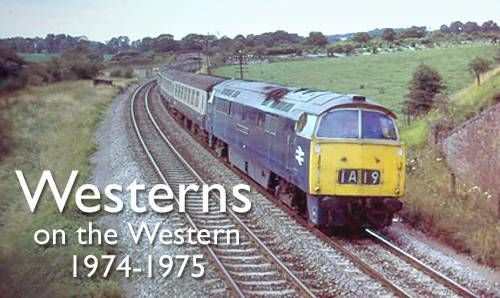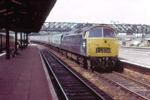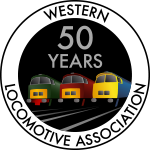WESTERNS ON THE WESTERN 1974 - 1975 by John Vaughan
Built between 1962 and 1964 and withdrawn between 1973 and 1977, it is hard to believe that examples of the fleet of 74 Class 52 2,700hp diesel-hydraulics have now spent twice as long in preservation than they did in service on British Railways. It is equally hard to believe that examples such as the preserved D1013 Western Ranger are now over 50 years old! John Vaughan, a man who probably did more for Western enthusiasts than anyone else, arranging many railtours to mark their demise, takes a nostalgic look back at their final two years of operation.
Judging by the popularity of the 'Westerns' during their last years of service they were undoubtedly the first of the diesel classes to enjoy almost a cult following, and although the Class 55 'Deltics' (and certain other now withdrawn classes) also enjoyed a huge band of supporters, this is nothing when compared with the adulation afforded to the Class 52s. Although, by way of recent example, many Class 47 followers turned out for the 'Duffs' last appearances on Virgin Train passenger train workings, for sheer weight of numbers, with a sustained obsession the Class 52 scene in the late 1970s was in a different league.
Left: Back in 1975 many main lines still operated with the infrastructure of yesteryear. In this view of Midgham on the Berks & Hants line, a down 'Western'-hauled express powers westward and passes Midgham's home signal, with its twin Maybach engines on full power. Although the crossing gates had by then been replaced by lifting bafflers, lower quadrant semaphore signals were still extant and the old mechanical signalbox continued to control all train movements over this section of line.
Although it was in 1955 that the British Transport Commission announced it was to eliminate steam traction from the entire British Railways network, there was still considerable regional autonomy in planning for the transition to diesel and electric traction and perhaps surprisingly this included locomotive procurement. Although a broad-brush statement, the Western Region chose a mainly diesel-hydraulic design path, drawing considerably on the experience of German railways, whereas other regions opted for diesel-electric locomotives (with a handful of exceptions).
German designs from companies such as Voith, Maybach and Krauss-Maffei were tried and tested and they relied on simpler design fundamentals that reduced complex electrical components to the minimum. Diesel-hydraulic locomotives could be constructed with similar power outputs to diesel-electric locos but with a considerable saving in weight, producing a far better 'power-to-weight-ratio'. There were problems in 'shoehorning' two high revving V12 diesel engines and all ancillary components into a locomotive built to the smaller UK loading gauge, size and weight limitations, but what emerged from the drawing board was arguably the most handsome diesel locomotive that has ever graced the rails of the erstwhile BR system.
Right: The 'C' in this train description '1C04' always designated that a train was destined for South Wales. In July 1974 a pristine No D1012 Western Firebrand was photographed entering Truro, the Capital of Cornwall. On the left is a dmu in the Falmouth branch bay platform while on the right is what was left of Truro goods yard. This locomotive was withdrawn in November 1975 and broken up at Swindon Works.
Although the Class 52s could, over their lifespan, be seen on most Western Region lines, their primary role was heading London to South Wales, London to Birmingham and London to Paignton, Plymouth and Penzance express passenger trains, although they were by no means regarded as 'passenger only' locos. They were popular with train crews because the ride was smooth; the cabs were comfortable and the power take-up even throughout the range. There were mechanical problems with final drives, transmission bearing failures, cracking in bogie frames and cracking in cylinder heads, the latter not being helped by a sophisticated three inlet and three exhaust valve per cylinder configuration. Also the highly stressed turbo-blower gas inlet casings regularly cracked, a problem that was never totally eliminated. However the majority of these problems were cured, and in their latter years the fleet became very reliable and in availability terms were comparable with most Type 4 Co-Co diesel-electrics.
Initially the class was allocated to Plymouth Laira, Bristol Bath Road, Cardiff Canton and Swansea Landore. However, because most of the primary express train services were to and from Paddington, London, the class could be seen in considerable numbers at Old Oak Common. The locos soon settled down and together with Class 47s became an integral part of Western Region main line services on most primary routes. Other diesel-hydraulics such as the Type 4 'Warships' and the Type 3 Class 35 'Hymeks' worked some main line and also secondary services, while 'Peak' 1Co-Co1 Type 4s worked alongside the 'Westerns' (and Class 47s) on inter-regional north east/south west services. Many early photographs show Class 52s at work on the old Great Western route from Paddington to Birmingham via Banbury. In the early years of service the class was so dedicated to main line expresses, that photographs of the class on freight workings became newsworthy.
Left: Brunel's great terminus of Paddington was the starting point for thousands of Class 52 'Western' hauled services. On 26 February 1977, the all over roof reverberated to the sound of the last of the 'Western' diesel hydraulics in every day service for the very last time, thus ending nearly 15 years of service. In this September 1974 view No D1021 Western Cavalier waits to depart with a Paddington-Plymouth service.
The maintenance of the locos called for complete overhauls only every four to five years and the high revving engines required light overhaul every 6,000 running hours, which would normally be achieved at approximately 18 month intervals. The engines were so light and accessible, due to extensive use of alloys, that they could be changed within a single working day. Sadly towards the end of their working life the 'Westerns' were deliberately neglected in terms of major overhauls and just basic servicing was carried out. If major faults occurred the locos were simply withdrawn from service, unless it was easy to cannibalise another class member. As the prime movers became worn in later years, many of the class could be quite smoky and plumes of exhaust could be produced, especially when the engines were cold or had been idling for a lengthy period.
When the end of diesel-hydraulics was announced, the 'Westerns' strangely were given an extended lease of life because the policy was to eliminate the less efficient MAN engined fleets first and then the 'Warships' followed by the 'Hymeks'. The first Class 52 to be withdrawn was in May 1973, and by the end of 1975 only 35 of the fleet remained in service. By February 1977 the entire class of 74 had been taken out of service. As more Class 47s became fitted with electrical train heating, which included the ability to provide air conditioning in the latest generation of Mark 2 coaches, and as the 100mph Class 50s arrived in increasing numbers from the London Midland Region, the number of Class 52s on class one services diminished. They were largely removed from the Birmingham and South Wales services and both Canton and Landore lost their allocations. They were then withdrawn from Bristol Bath Road, and by 1976 the class was officially restricted to freight services so that engine ratings could be slightly reduced and the slower speeds would result in the remaining locos lasting a little longer. However, despite the ruling the 'Westerns' regularly headed express trains and during their last year or so in service any news that one of the class was working a 'passenger' would see hoards of enthusiasts coming out of the woodwork to either travel behind (bash!) or photograph the relevant train.
Right: A grand sight for the diesel hydraulic connoisseur is a Class 52 at the head of the famous 'Cornish Riviera' that runs from Paddington to Penzance. The 'give away' is headcode 1B45, a useful facility for photographers seeking train identity. In August 1975 the train is passing a group of permanent way workers in their high visibility jackets just east of Old Oak Common.
A delay in the delivery of High Speed Trains provided a stay of execution for the 'Westerns' and in their last year of service they could be seen almost anywhere on the Western Region including boat trains from Paddington to Fishguard, summer Bristol to Weymouth workings, freight from Yeovil Junction to Westbury, stone trains from Merehead and Whatley Quarries to various terminals, including one at Leagrave, just north of St Albans on the Midland Region, on the Paignton and Newquay workings on summer Saturdays, on china clay trains in Cornwall and even forays into Birmingham from both London and Bristol. It is interesting to note that the Class 52s defeated the new TOPS numbering system where locos numbers within a class were prefixed by the class number. The cast name and number plates were presumably not worth removing from a doomed class and although on some locomotives the 'D' was painted over the I0xx numbers were retained to the end.
Towards the end of their lives the Class 52s were repeatedly requested as the preferred motive power for enthusiast specials. The locomotives made such a tremendous sound that the leading coach, normally 'Coach A', was in great demand. The class reached many obscure corners of the BR network, including several off region trips, during their final months and some of the specials were so popular that repeat tours and relief trains were required. There was even one excursion, in fact the last privately organised tour (organised by the author!), which ran on a Thursday!
Left: The classic time honoured location of Sonning Cutting in August 1974, finds now preserved No D1015 Western Champion making its way up to Paddington with a mixture of Mk1 and 2a stock in tow. The 'Westerns' were capable of the magic 'ton' in favourable conditions.
The final day came on 26 February 1977 when a triangular main line tour called 'Western Tribute' was operated by the Western Region from Paddington to Swansea, Swansea to Plymouth and then from Plymouth to Paddington. This was a moving occasion watched by thousands and experienced by the 650 participants that wedged the train, with D1013 Western Ranger and D1023 Western Fusilier double heading. Ironically the majority of the class were cut up at Swindon, which was the birthplace of 30 of the class. Fortunately the preservationists were soon on the scene and half a dozen examples were saved from oblivion. Thus it is still possible to hear the 'Maybach music' from these very distinctive locomotives.
From a personal perspective I think that except for Cornwall and the Western States of the USA, the happiest days of a 40-year 'career' in railway photography was spending sunny summer days on the 'Berks & Hants' line watching a string of expresses running through the Bedwyns and climbing towards Savernake, taking thousands of people on their annual summer holidays in the West Country. Sometimes with a Southwest wind blowing the Class 52s could be heard on the wind at least a couple of miles distant, especially with over 400 tons in tow. Strangely what goes around comes around and some of the latest diesel units incorporate diesel hydraulic transmission. But they will never have the aura or charisma of the classic and unique 'Westerns'.
Article kindly reproduced with permission of John Vaughan and Railways Illustrated.







